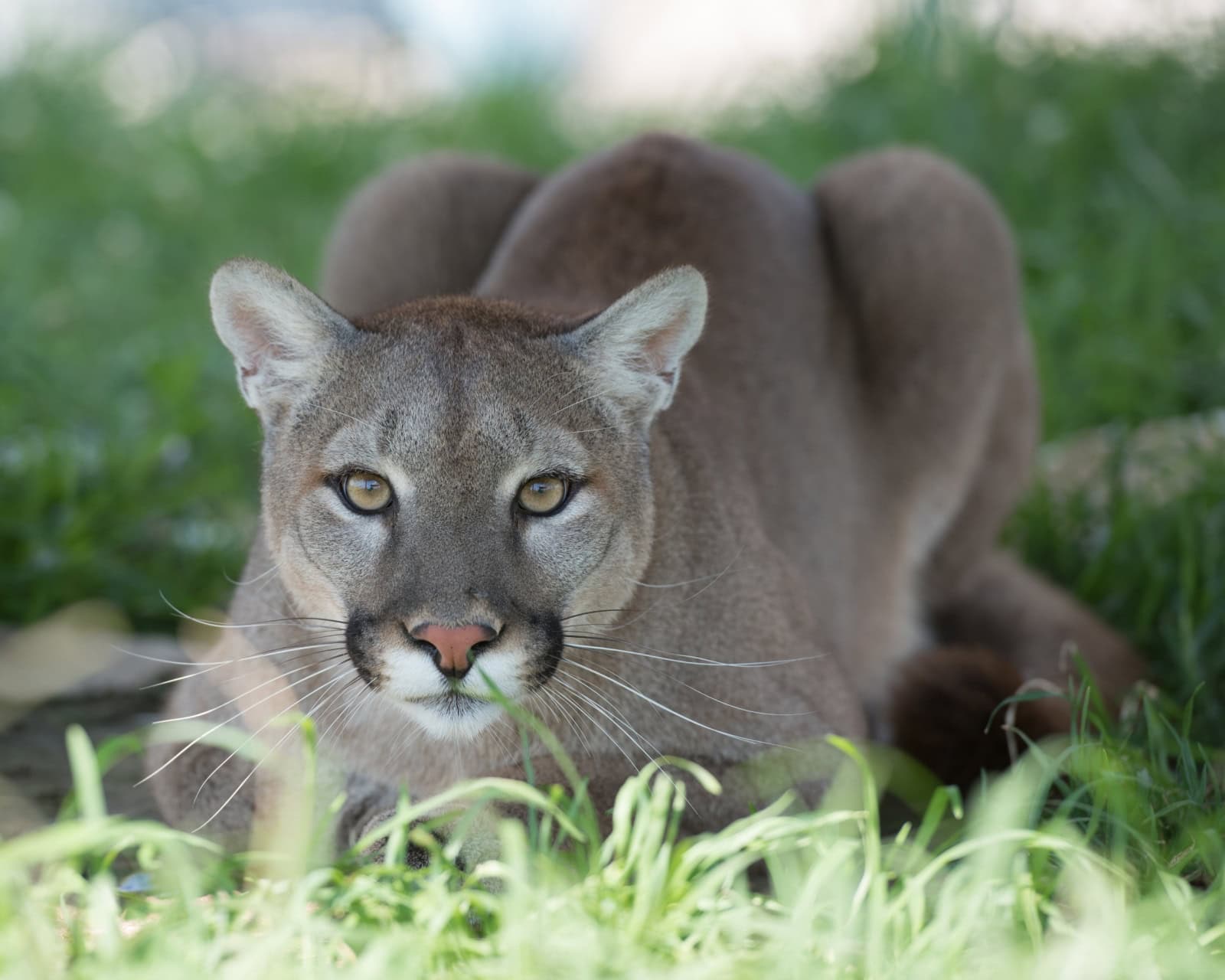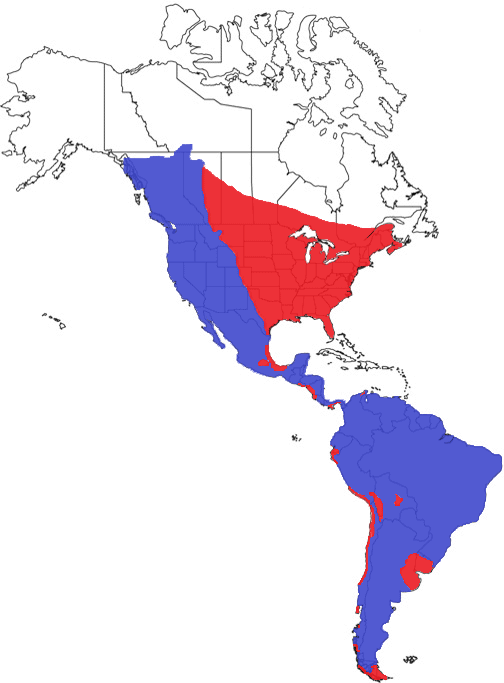
Taxonomy
Kingdom: Animalia
Phylum: Chordata
Class: Mammalia
Order: Carnivora
Family: Felidae
Subfamily: Felinae
Genus: Puma
Species: concolor
Scientific Name: Puma concolor
IUCN Red List Status: Least Concern, but population is decreasing
About
Habitat: Mountain lions are the widest distributed mammal, ranging from North America to South America. Due to their broad distribution, they are found in a wide variety of habitats such as forests, deserts, and mountains. They tend to prefer rough, rocky terrain with moderately dense, low vegetation. For mountain lions to survive successfully in an area, they have three main requirements: freedom from excessive human interference, dense forest cover for hunting, and adequate prey populations, like large ungulates.

Territoriality: Mountain lions are extremely territorial, males will occupy a territory of about 150 square miles. A male will actively protect his territory by continually walking around the perimeter. If another male comes near, the original male will fight to defend his territory. Females will typically occupy about 50 square miles; they will not actively defend and fight, but they do tend to avoid each other. One male’s boundaries will usually overlap two to three females’ territories, all for the potential for him to breed with them. As young mountain lions mature, females will generally stay close to their mother, but males will roam further away. To avoid inbreeding, a male may travel up to 100 miles away.
Lifespan
In the Wild: Up to 10 years
In Captivity: Up to 20 years
Population
Estimated 20,000 – 40,000 in the United States
Physical Description
Weight: 80-200 pounds
Length: 7-8 feet (nose to tail)
Mountain lions are the largest member of the cat family in North America. They vary in size and weight, with males being larger than females. Compared to other wild cat species in the United States, mountain lions are much larger than lynx or bobcats and have a long tail that measures one-third of their total body size. Mountain lions have short, coarse fur that can be in two color phases- red and gray. The red phase varies from buff, cinnamon, and tawny to a very reddish color. The gray phase varies from silvery gray to bluish and slate gray. Some parts of their body, such as their muzzle and tip of the tail, are black. Newborn mountain lions are heavily spotted for the first three months of their life, but the spots begin to fade soon after. These spots have usually disappeared by six months of age, but it can vary depending on the cat.

History
Mountain lions were once found over most of the Western Hemisphere from Canada to the tip of South America, and from the Pacific to the Atlantic oceans. During the time of European settlement into the United States, mountain lion populations saw an enormous decline. The early settlers feared the cats and believed they had a negative effect on game populations. By the 1800s, these cats were extirpated or severely reduced in the eastern U.S due to the human population increase. Because of this increase, mountain lion habitats declined, and their primary source of food, whitetail deer, saw a significant loss. In the western U.S, mountain lion populations were lowered by the 1900s. By the late 1960s, mountain lions were given game-mammal status in many states, leading to a broader range of population management and programs. After this was enacted, their populations began steadily increasing in numbers.
Today’s mountain lion population only exists in a fraction of their historic range. While they may not be as populous as they once were, mountain lions can survive in an incredibly diverse array of ecosystems. They currently span 28 countries in North, Central, and South America. Fifteen western states and Florida actively acknowledge breeding populations, while many other states have occasional sightings of the species.
Reproduction
Gestation: 90 days
Litter size: 1 to 4 (2 to 3 average)
Mountain lions are capable of breeding at any time during the year, but most give birth between April and July, following a three month gestation period. During the breeding season, the infamous scream of the female mountain lion may be heard; this scream is used to attract males. When it is time to give birth, females will find a den in a secure location. An average of 2-3 young, called kittens, are born and rely solely on the mother. She will defend them against males who may try to kill them. Kittens will nurse exclusively for two months; then they will accompany their mother on hunting trips to learn. Young mountain lions stay with the mom for two years. After this time, young males will travel hundreds of miles away to find a new territory.
Diet and Hunting Behaviors
A mountain lion is an obligate carnivore, meaning they solely eat meat. Deer are their primary prey, but they are not limited only to deer. They will prey on other ungulates such as elk, moose, and sheep, as well as smaller mammals such as rabbits, porcupines, and skunks. In places where human development has taken over mountain lion habitat, the cats have been known to prey on livestock, domestic horses, dogs, and cats.
Mountain lions are known as ambush hunters who will wait patiently in dense vegetation or rock crevices. Once their prey has walked by, the cat will silently stalk behind, which results in a quick, surprise attack. They will kill with a powerful bite below the base of the skull, usually breaking the neck. Once their prey is dead, mountain lions will drag the carcass to a sheltered spot, eating 20 to 30 pounds in one sitting. Once they are full, they will bury it under dirt, leaves, or snow to return to later.
Threats
Mountain lions used to roam nearly all of the United States. After becoming a highly sought after hunting trophy and a history of attacking livestock, they were persecuted by both hunters and farmers. By the 1900s, mountain lions were eliminated from nearly all of their range in the Midwest and Eastern United States. Because they exist across the country, some in small, isolated populations, all mountain lions face threats such as trophy hunting, poisoning, predator control, and habitat loss.
Today, mountain lions are found primarily in the western part of the United States, but have been seen in more eastern states such as Missouri and Arkansas. In 2011, a subspecies of mountain lion, the eastern cougar, was declared officially extinct by the U.S. Fish & Wildlife Service. Florida panthers, another subspecies in the United States, is listed as critically endangered as there are only an estimated 120-230 combined juveniles and adults remaining. Efforts to preserve the species were officially created in the 1960s, but people are not always eager to help predator populations recover.
Due to the mountain lion’s ability to travel long distances, the cats occasionally wander into areas that may seem inappropriate, including places densely settled by humans. Even though their appearances are almost always extremely brief, public panic can lead to the pursuit of the animal.
For people who live in or around wildlife habitats, mountain lion sightings and attacks on pets or livestock may occur. Attacks by mountain lions are rare, but there are ways to prevent them from occurring. If you have any questions or concerns about wildlife in your area, contact your local wildlife management officers.
The conservation of mountain lions depends on the preservation of large amounts of habitat. They require about 13 times as much area as a black bear or 40 times as much as a bobcat to thrive. By preserving enough wilderness to support a stable mountain lion population, countless other species of plants and animals can benefit.
Mountain Lion Safety
- Keep your distance, and take this rare encounter very seriously. DO NOT approach the cat
- Seem as large as possible, pick up small children, leash pets, and stand close to those around you. Open your jacket and raise your arms, and wave them slowly.
- Make loud noises that do not sound like a prey animal, such as banging your water bottle or walking stick. Speak slowly and loudly to disrupt the mountain lion’s hunting instincts.
- Do not act afraid, act defiant by maintaining eye contact, and DO NOT run away. DO NOT bend over or crouch down. Throw stones or branches and aggressively wave your arms.
- Slowly create distance and assess which direction to take. Without turning your back to the mountain lion, do not move towards kittens or prey. Give the lion the time and space to get away from you.
- Protect yourself if the mountain lion is to attack you. Protect your neck and throat by using rocks, jackets, garden tools, tree branches, but do not give up.